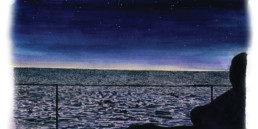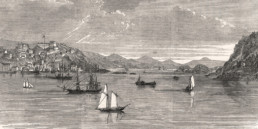An Island Funeral
An archipelagic community whose members join in mourning
By Christina M Gillis
Mrs. Moore died last Thursday and was buried Saturday it was thought to be the largest funeral ever attended on this island. The Cutter from Bass Harbor brought over a great many, and other boats from various places in Tremont [mainland township].
As described in the diary of one Susanna Gott, it is not difficult to imagine this flotilla of boats approaching the Gotts Island dock on a day in 1852. The funeral for the wife of Capt. Philip Moore was a major event attracting, as Susanna writes, an unusual number of mourners; and all, except for the local Gotts islanders, would be arriving in boats.
Some 80 years later, in September 1935, N.C. Wyeth sat on the porch of his home at Port Clyde and watched, as Susanna had done, a large number of boats—lobster boats, sailing boats, perhaps even skiffs— heading for another island funeral. This one would be happening on nearby Teel’s Island, and it would be celebrating the locally legendary fisherman Rufus Teel.
Wyeth would have known Rufus Teel, and he would certainly have known why the boats were heading to Teel’s Island that day. His youngest daughter Ann, a musician, recalled viewing the funeral flotilla with her father and later would compose a piece titled Island Funeral; her father, inspired by the scene, created the sketch that would become, four years later, the famous painting of that name.
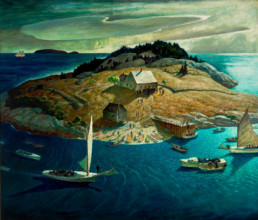
Island Funeral, 1939, N. C. Wyeth (1882-1945).
Brandywine River Museum of Art, Gift of E. I. du Pont de Nemours and Company in honor of the Brandywine Conservancy and Museum of Art’s 50th Anniversary, 2017.
Wyeth was no stranger to the sight of boats in motion in a brilliantly blue sea. In July of that same summer, he had described to his oldest daughter Henriette a scene—also from his porch at Port Clyde—where the retreating fog revealed “the blue-jeweled water, the familiar green islands, the moving flecks of white, yellow, and green boats.”
But on the day of Rufus Teel’s funeral Wyeth knew he was witnessing, as Susanna Gott had done, a special occasion, a public and established celebration for which the local community was sure to turn out. Both diarist and artist were viewing a ritual event, one particular to islands and islanders. The boats on that September day were more than “moving flecks” of color against a brilliantly blue canvas. They shared a common destination.
At first it seems that Wyeth may have been less interested in the funeral itself than in that scene of the moving boats. Creating the sketch, which includes the major compositional elements of the final painting, allowed him to hold on to what was an “at the moment” experience: to freeze on paper the motion he was observing. From his home in Port Clyde, the artist would have been able to observe also, however, both the forward motion of the flotilla of boats and their gradual slowing and coming to dock, anchor, or mooring at Teel’s Island.
The bird’s eye perspective, noteworthy in both sketch and finished painting, enabled him to represent both journey and arrival.
To a viewer not familiar with the island funeral ritual that Wyeth observed that day (a ritual that remains), it is not entirely clear, absent the title of the painting and the account of its inception, that a funeral, the celebration of a life and a death, is the subject of the painting.
Rather, the boats dominate our attention. Perry Westbrook, in a classic study of Swan’s Island (a neighbor of Gotts), described what he called a “floating funeral,” a “procession of dories [filing] slowly across the water.”
If Westbrook’s account foregrounds the boats as they approach the island’s shore, so too, the craft that Wyeth depicts, in all their variety, command the space at the front of the picture plane. The life in this painting is in good measure represented by the motion of those boats and the sea on which they move.
The stasis that dominates a funeral scene like Gustave Courbet’s Burial at Ornans or Rockwell Kent’s Burial of a Young Man, the latter set on Monhegan Island, is absent from both Susanna Gott’s account and Wyeth’s painting. What was important for the local diarist, and appears to have been so for Wyeth, is not a group of grieving mourners standing in place, but rather the motion involved in travel and the processes of landing on the rough and uneven shore that Wyeth would later characterize as a “very masculine coastline.”
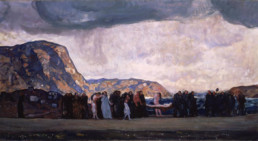
Burial of a Young Man, circa 1908-1911, Rockwell Kent (1882-1971).
Courtesy of The Phillips Collection
I am told by a local friend that the 21st century Teel’s Island (now in private hands) has changed significantly over the decades, but is still clearly recognizable as the place Wyeth represented in 1939. Teel’s is clearly not a community as was the 19th-century island where Susanna Gott lived and recorded events in her diary. It has no church or formal cemetery, and if buried on the island, Rufus Washington Teel would presumably have occupied a space on the family property. A light meandering line in Wyeth’s painting suggests a stone wall, but its function is unclear. There is no indication that it marks a special burial space.
None of this means, however, that Rufus Teel’s island was an isolated place. Wyeth provides the sense of surrounding islands, Monhegan for example, which occupies a space in the upper left section of the canvas. In a community of islands, the sea is not so much a dividing or separating element as a field that connects small land masses to one another. The sea in Wyeth’s painting defines an archipelagic community, one whose members would naturally attend a funeral on a neighboring island.
The array of skiffs and dories drawn up on the island’s small beach attests to how many people have already arrived from other islands (as well as the mainland). But the journey does not stop there. Now those who have arrived are making their way in processional order, tiny figures in a larger field, up a path from the shore to the Teels’ small house. We have the sense of continued, continuous, action. Even as a recently arrived group climbs the hill to join those already gathered at Teel’s house, other boats are approaching from both the left and right sides of the canvas, each crammed—overloaded it would seem—with more celebrants.
In the calculus of mortality that Wyeth represents in Island Funeral, the death of a single person, living on a single island, is hardly proportionate to the large numbers coming to his funeral. This is not an “insular” world in the sense that the word is often used; nor are the Teels—and other islanders—among those whom Herman Melville (in Moby Dick) referred to as “isolatoes.” Death, after all, is never an isolated incident.
Like Susanna Gott, N.C. Wyeth reminds us too that arrivals at islands, as opposed to mainland places, are always events in themselves, never more so than when the visitors are coming for a ritual occasion. Everything appears to be in motion. The activity of the passengers disembarking, making their way across the shore area—dock, sand, or stone—and then climbing the hill, mirrors that of the boats still nearing the island.
While some of the boats are still under sail, one, already moored, is caught in the process of moving its passengers into the small boat in which they will be rowed ashore; one individual is already seated in the stern of the skiff, which the boatman holds close to the larger launch while a third person awkwardly climbs aboard. Still others remain seated in the larger boat awaiting their turn.
Challenges abound. As passengers already discharged into skiffs and dories make their way toward the shore, the offloaded passengers of yet another small boat, having reached the dock, struggle to climb a long ladder to reach the top (why, we wonder, is this event happening at low tide, when the climb will be so difficult?).
As all islanders know, arrivals, particularly those involving large numbers of people, are seldom without complication. Though motivated by an event to be shared, the boats as Wyeth represents them are all still engaged in their own individual business, their own stage in a general process. They move in their own time, their passengers not yet having set foot in the place where mortality will be communally experienced, marked, and remembered.
But where, in Island Funeral, do we see the presence of death itself; or more accurately, how do we see mortality in this painting? Without the title, without the background information about Rufus Teel’s death, I question again how an observer unfamiliar with Maine island culture would know that this congregation of people was not celebrating, for example, a wedding or other special occasion.
Exhibited at the MacGallery in New York in 1939 in a show titled “In the Georges Islands” (a reference to the St. George peninsula where the Wyeths were summer residents), Island Funeral was described in the gallery’s catalogue as calling up a “world … both grave and lyric.” The painting marked for illustrator N.C. Wyeth a major turn in a highly successful career that had depended on narrative and dramatic representation. But the particular mode of gravity and lyricism, subtle but unmistakable in Island Funeral, takes us far from the famous action scenes Wyeth created, for example, in his Treasure Island illustrations.
Further, when Wyeth revisited Teel’s Island in the 1940 painting John Teel with his Daughter and Granddaughter (also titled Fisherman’s Family), he created a place recognizable as that in Island Funeral but yet strikingly different. The quality of graveness that suffuses the three characters in the later painting translates rather into a kind of Maine sturdiness.
We are looking at three “real” or recognizable characters standing staunchly by a shed, with the family house in view at the top of the craggy hill behind them. That same hill, same cottage, are far more abstracted in Island Funeral. The hill is long and steep, almost barren, the human elements are reduced to specks, the house, also miniaturized, is perched unnaturally at the top of the slope, casting a long shadow toward the shore. In the distance, Monhegan Island looms out of a darkened sea.
Wyeth asked his son-in-law Peter Hurd to write the catalogue introduction because, he said, the latter possessed a necessary “sympathetic and intelligent knowledge of background”; he would understand “what lies back of my aspirations.”
It is perhaps the “background,” what lies behind the painting, that Peter Hurd took into account when he wrote in the catalogue that Wyeth’s work “compels” us to ponder a vision of “form and color and substance and shadow.”
The interchange of “substance and shadow” bespeaks an ambiguity, perhaps even an unknowing, that suffuses Island Funeral. This is, after all, an island world. What may be thought of as firm and demarcated—island, edge, sea—is actually far less so.
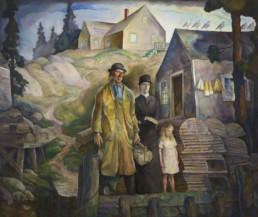
John Teel with his Daughter and Granddaughter, N. C. Wyeth (1882-1945).
Courtesy of the Brandywine Museum
An island occupies a position unlike that of a large land mass. As suggested by the old English word for island—“igland,” referring to water—the island is of the land and of the sea. Islanders know that some borders, like the edges of the island that are subject to the will of the tide, are fluid, that in an islocentric world, the line between land and sea shifts with weather and tide.
In a moving letter to his daughter Ann in September 1936, N.C. describes being almost submerged when caught by a wave on a rising tide: “The tides are exceptionally high just now of course (full moon), and the banks look hardly capable of holding the crest flood,” he wrote. “I felt more alone than ever before in my life.”
Later, in that same letter, he tells his daughter that he and son Andy “have plans for several painting expeditions—one of them to Teel’s Island.”
As witnessed in Wyeth’s experience with the wave, the edge or shore is tenuous at best. Few straight and continuous lines occur in nature. Wyeth’s island shore that must be crossed by the funeral celebrants is a space of mixed features: no clearly demarcated border but rather a confused and irregular zone of dock, small sand beach, rough protruding dark rock. Its irregularity, in another mirroring, suggests that of the human arrival scene itself. Nothing is smooth or easy.
Not in itself an ultimate destination, but rather one stage in a longer journey, the shore in Island Funeral is, then, not exactly an arrival point after all. Commentators such as Jonathan Raban and Rachel Carson have pointed out that for denizens of small islands, the sea is always a beginning. But where then is the arrival? At the shore, as Wyeth’s painting suggests, one form of mobility—from boat to foot—substitutes for another in a space of transition that witnesses both arrivals and departures, an amorphous boundary central to both.
Anthropologist John Fiske has reminded us that we humans are drawn to binary oppositions: land as culture, sea as “untamed nature” or as WH Auden argued (in Enchafed Flood, a study of Romantic iconography of the sea) a “primordial undifferentiated flux” from which, according to Genesis, God “let the dry land appear.” But the shore, Fiske argues, should be seen rather as a space of change and transformation; it “mediates this terrifying boundary.” In arriving at the shore, then, the figures in Wyeth’s painting enter a kind of third space.
But still, despite confusion, motion, and movement, Rufus Teel has crossed a clearly demarcated border. In the face of death, what, Wyeth may be asking in Island Funeral, can be mediated? The bright, almost lurid, sunlit hillside of the island—the striking blue the product of a new DuPont pigment to which Wyeth, through personal connections, had access—leaves little space for ambiguity. The death of one inhabitant has imposed singularity on this place, something that will not change. The shadowy fields that dominate the far left side of the island, their grasses turning red in late summer afternoon light, fall away into a dark sea. And in the far distance, in the direction of Monhegan, a large “coaster” carrying freight to coastal ports sails sedately on, as if of another world, unconcerned with merely mortal events.
Underlying all the motion and movement in Island Funeral, then, is death itself: a final stasis. If the Teel home stands in for the mortality of Rufus Teel, it is the symbolic destination of all those climbing out of the boats, all joining the processional march up the hill. In this reading, the bright color, the contrasts, the suggestion of vibrant activity that transmits a sense of life in Island Funeral, contribute ultimately to a deep irony.
Wyeth’s bird’s-eye perspective distances viewers from those tiny actors in the scene, their activity frozen on the canvas. The miniscule scale reinforces the gap between art and the world lived in time: the world in motion. As critic Susan Stewart observed in On Longing, the miniature creates an “other” time, one that “negates change and the flux of lived reality.”
Here, then, is the paradox implicit in Island Funeral. Even as they are engaged in all the motion and activity of traveling to the island, participating in an elaborate arrival, and then climbing in processional order to the scene of the funeral (which we never see), these small figures, none clearly defined, are subject to forces beyond human control: the motion of sea, wind, current, and tide; and finally the stasis of mortality itself. In time beyond that depicted in the painting, whether at mooring, dock, or beach, the boats will come permanently to rest.
Christina Marsden Gillis lives in Berkeley, California, but has spent almost all the summers of her adult life on Gotts Island. She is the author of two collections of island-themed essays, Writing on Stone: Scenes from a Maine Island Life (2008) and Where Edges Don’t Hold (2017); her work has appeared in numerous journals and has been listed as “notable” in several issues of Best American Essays.




